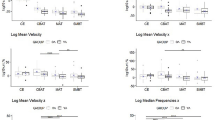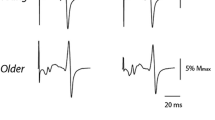Abstract
Purpose
This study was designed to investigate the influence of a cognitive task on the responsiveness of the homonymous Ia afferents pathway during upright standing in young and elderly adults.
Methods
Twelve young and twelve elderly adults stood upright on a foam surface positioned over a force platform, and performed a colour-naming test (cognitive task) with two cognitive loads: congruent and incongruent colour conditions. The rate of correct response in naming colour (accuracy) and associated reaction time (RT) were recorded for the cognitive task. The excursion of the centre of pressure and surface electromyogramme (EMG) of leg muscles were measured. Modulation in the efficacy of homonymous Ia afferents to discharge spinal motor neurones was assessed by means of the Hoffmann (H) reflex method.
Results
The accuracy and RT were similar in the congruent condition between young and elderly adults (p > 0.05), and increased for both age groups in the incongruent condition, but more so for elderly adults (p = 0.014). In contrast, the H reflex amplitude did not change with the cognitive load. The excursions of the centre of pressure in the sagittal plane and muscle EMG did not vary with colour conditions in both groups (p > 0.05).
Conclusion
This study indicates a lack of modulation in the efficacy of group Ia afferent to activate soleus motor neurones with the cognitive demand of a concurrent task during upright standing in young and elderly adults.



Similar content being viewed by others
References
Abrahamová D, Hlavacka F (2008) Age-related changes of human balance during quiet stance. Physiol Res 57:957–964
Andersson G, Hagman J, Talianzadeh R, Svedberg A, Larsen HC (2002) Effect of cognitive load on postural control. Brain Res Bull 58:135–139
Baudry S, Duchateau J (2012) Age-related influence of vision and proprioception on Ia presynaptic inhibition in soleus muscle during upright stance. J Physiol 590:5541–5554
Baudry S, Lecoeuvre G, Duchateau J (2012) Age-related changes in the behavior of the muscle-tendon unit of the gastrocnemius medialis during upright stance. J Appl Physiol 112:296–304
Bélanger S, Belleville S, Gauthier S (2010) Inhibition impairments in Alzheimer’s disease, mild cognitive impairment and healthy aging: effect of congruency proportion in a Stroop task. Neuropsychologia 48:581–590
Berger L, Bernard-Demanze L (2011) Age-related effects of a memorizing spatial task in the adults and elderly postural control. Gait Posture 33:300–302
Brink TL, Yesavage JA, Lum O, Heersema PH, Adey M, Rose TL (1982) Screening tests for geriatric depression. Clin Gerontol 1:37–43
Carpenter MG, Frank JS, Winter DA, Peysar GW (2001) Sampling duration effects on centre of pressure summary measures. Gait Posture 13:35–40
Crone C, Hultborn H, Mazières L, Morin C, Nielsen J, Pierrot-Deseilligny E (1990) Sensitivity of monosynaptic test reflexes to facilitation and inhibition as a function of the test reflex size: a study in man and the cat. Exp Brain Res 81:35–45
Doumas M, Smolders C, Krampe RT (2008) Task prioritization in aging: effects of sensory information on concurrent posture and memory performance. Exp Brain Res 187:275–281
Earles DR, Koceja DM, Shively CW (2000) Environmental changes in soleus H-reflex excitability in young and elderly subjects. Int J Neurosci 105:1–13
Fitzpatrick R, Rogers DK, McCloskey DI (1994) Stable human standing with lower-limb muscle afferents providing the only sensory input. J Physiol 480:395–403
Fraizer EV, Mitra S (2008) Methodological and interpretive issues in posture-cognition dual-tasking in upright stance. Gait Posture 27:271–279
Goulart F, Valls-Solé J, Alvarez R (2000) Posture-related changes of soleus H-reflex excitability. Muscle Nerve 23:925–932
Heuninckx S, Wenderoth N, Debaere F, Peeters R, Swinnen SP (2005) Neural basis of aging: the penetration of cognition into action control. J Neurosci 25:6787–6796
Heuninckx S, Wenderoth N, Swinnen SP (2008) Systems neuroplasticity in the aging brain: recruiting additional neural resources for successful motor performance in elderly persons. J Neurosci 28:91–99
Horne JA, Ostberg O (1976) A self-assessment questionnaire to determine morningness-eveningness in human circadian rhythms. Int J Chronobiol 4:97–110
Jamet M, Deviterne D, Gauchard GC, Vançon G, Perrin PP (2007) Age-related part taken by attentional cognitive processes in standing postural control in a dual-task context. Gait Posture 25:179–184
Klass M, Baudry S, Duchateau J (2011) Modulation of reflex responses in activated ankle dorsiflexors differs in healthy young and elderly subjects. Eur J Appl Physiol 111:1909–1916
Koceja DM, Trimble MH, Earles DR (1993) Inhibition of the soleus H-reflex in standing man. Brain Res 629:155–158
Li KZ, Lindenberger U (2002) Relations between aging sensory/sensorimotor and cognitive functions. Neurosci Biobehav Rev 26:777–783
MacLeod CM (1991) Half a century of research on the Stroop effect: an integrative review. Psychol Bull 109:163–203
Nasreddine ZS, Phillips NA, Bédirian V, Charbonneau S, Whitehead V, Collin I, Cummings JL, Chertkow H (2005) The Montreal cognitive assessment, MoCA: a brief screening tool for mild cognitive impairment. J Am Geriatr Soc 53:695–699
Peterka RJ (2002) Sensorimotor integration in human postural control. J Neurophysiol 88:1097–1118
Proske U, Gandevia SC (2012) The proprioceptive senses: their roles in signaling body shape, body position and movement, and muscle force. Physiol Rev 92:1651–1697
Rankin JK, Woollacott MH, Shumway-Cook A, Brown LA (2000) Cognitive influence on postural stability: a neuromuscular analysis in young and older adults. J Gerontol A Biol Sci Med Sci 55:M112–M119
Rudomin P, Schmidt RF (1999) Presynaptic inhibition in the vertebrate spinal cord revisited. Exp Brain Res 129:1–37
Schieppati M (1987) The Hoffmann reflex: a means of assessing spinal reflex excitability and its descending control in man. Prog Neurobiol 28:345–376
Seidler RD, Bernard JA, Burutolu TB, Fling BW, Gordon MT, Gwin JT, Kwak Y, Lipps DB (2010) Motor control and aging: links to age-related brain structural, functional, and biochemical effects. Neurosci Biobehav Rev 34:721–733
Shaffer SW, Harrison AL (2007) Aging of the somatosensory system: a translational perspective. Phys Ther 87:193–207
Simoneau EM, Billot M, Martin A, Perennou D, Van Hoecke J (2008) Difficult memory task during postural tasks of various difficulties in young and older people: a pilot study. Clin Neurophysiol 119:1158–1165
Solopova IA, Kazennikov OV, Deniskina NB, Levik YS, Ivanenko YP (2003) Postural instability enhances motor responses to transcranial magnetic stimulation in humans. Neurosci Lett 337:25–28
Stroop JR (1935) Studies of interference in serial verbal reactions. J Exp Psychol 18:643–661
Swanenburg J, de Bruin ED, Favero K, Uebelhart D, Mulder T (2008) The reliability of postural balance measures in single and dual tasking in elderly fallers and non-fallers. BMC Musculoskelet Disord 9:162
Tahayori B, Port NL, Koceja DM (2012) The inflow of sensory information for the control of standing is graded and bidirectional. Exp Brain Res 218:111–118
Tokuno CD, Taube W, Cresswell AG (2009) An enhanced level of motor cortical excitability during the control of human standing. Acta Physiol 195:385–395
Weaver TB, Janzen MR, Adkin AL, Tokuno CD (2012) Changes in spinal excitability during dual task performance. J Mot Behav 44:289–294
West RL (1996) An application of prefrontal cortex function theory to cognitive aging. Psychol Bull 120:272–292
Woollacott M, Shumway-Cook A (2002) Attention and the control of posture and gait: a review of an emerging area of research. Gait Posture 16:1–14
Zysset S, Schroeter ML, Neumann J, von Cramon DY (2007) Stroop interference, hemodynamic response and aging: an event-related fMRI study. Neurobiol Aging 28:937–946
Acknowledgments
The authors thank Prof. Axel Cleeremans and Prof. Jacques Duchateau for helpful comments on a draft of the manuscript, Julia Eberlen-Spreer and Axel Dugeny for assistance in programming the cognitive task and data collection. Dr. Gaillard is supported by a grant of the Brussels Institute for Research and Innovation (Innoviris BB2B 2012-1-107). Dr. Baudry is supported by a grant of the “Fonds National de la Recherche Scientifique (FRS-FNRS)” of Belgium.
Author information
Authors and Affiliations
Corresponding author
Additional information
Communicated by Fausto Baldissera.
Rights and permissions
About this article
Cite this article
Baudry, S., Gaillard, V. Cognitive demand does not influence the responsiveness of homonymous Ia afferents pathway during postural dual task in young and elderly adults. Eur J Appl Physiol 114, 295–303 (2014). https://doi.org/10.1007/s00421-013-2775-8
Received:
Accepted:
Published:
Issue Date:
DOI: https://doi.org/10.1007/s00421-013-2775-8




